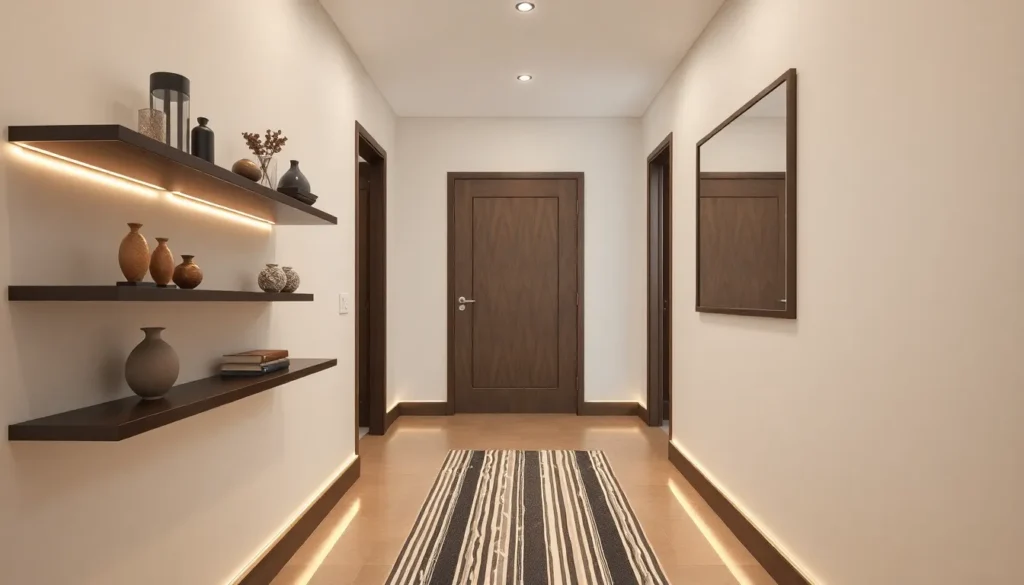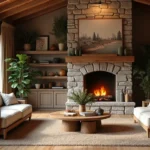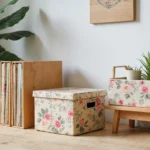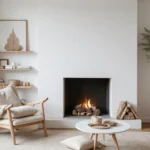Narrow hallways don’t have to be design afterthoughts that we simply tolerate. These overlooked spaces present incredible opportunities to showcase our creativity and maximize every square inch of our homes. Whether we’re dealing with a cramped entryway or a long skinny corridor, the right design approach can transform these challenging spaces into stunning focal points.
We’ve all walked through narrow hallways that feel cramped and uninspiring. But what if we told you that these tight spaces could become some of the most impressive areas in your home? With clever storage answers, strategic lighting, and thoughtful decor choices, we can turn any narrow hallway into a functional and beautiful passage.
The key lies in understanding how to work with limited width rather than against it. From vertical storage tricks to color schemes that create the illusion of space, we’re about to explore proven strategies that’ll make your narrow hallway feel twice as wide and infinitely more welcoming.
Maximize Storage With Built-In Solutions
Built-in storage answers transform narrow hallways from wasted space into highly functional areas that serve multiple purposes.
Install Floor-to-Ceiling Shelving Units
Floor-to-ceiling shelving units create maximum vertical storage while maintaining the hallway’s narrow footprint. We recommend installing custom shelving that spans from floor to ceiling along one wall, utilizing every inch of available height for books, decorative items, and everyday essentials.
Shallow shelving units work best in narrow spaces, with depths ranging from 6 to 10 inches to avoid overwhelming the corridor. Built-in units can incorporate different shelf heights to accommodate various items like photo frames, small baskets, or seasonal decorations.
Consider adding lighting strips under each shelf to illuminate stored items and create ambient lighting throughout the hallway. These LED strips enhance both functionality and visual appeal while making the space feel more open.
Add Hidden Storage Behind Wall Panels
Hidden storage behind wall panels offers discreet organization without compromising the hallway’s clean aesthetic. We suggest installing recessed cabinets that sit flush with the wall surface, creating seamless storage for items like cleaning supplies, coats, or household documents.
Magnetic latches or push-to-open mechanisms eliminate the need for visible hardware, maintaining smooth wall surfaces. These hidden compartments can be painted to match surrounding walls, making them virtually invisible until needed.
Wall panel storage works exceptionally well for frequently used items that you want easily accessible but out of sight. Consider installing multiple panels at different heights to create organized zones for various family members or item categories.
Create Under-Stair Storage Compartments
Under-stair storage compartments use previously unused space beneath staircases that adjoin narrow hallways. We recommend installing pull-out drawers or sliding shelves that maximize accessibility in these typically awkward triangular spaces.
Custom-built compartments can accommodate seasonal items, luggage, sports equipment, or household supplies that don’t require daily access. These storage areas often feature angled shelving that follows the staircase’s natural slope.
Consider installing a combination of closed cabinets for unsightly items and open shelving for decorative storage baskets or bins. This approach maintains visual interest while providing practical organization answers in otherwise wasted square footage.
Brighten Your Space With Strategic Lighting
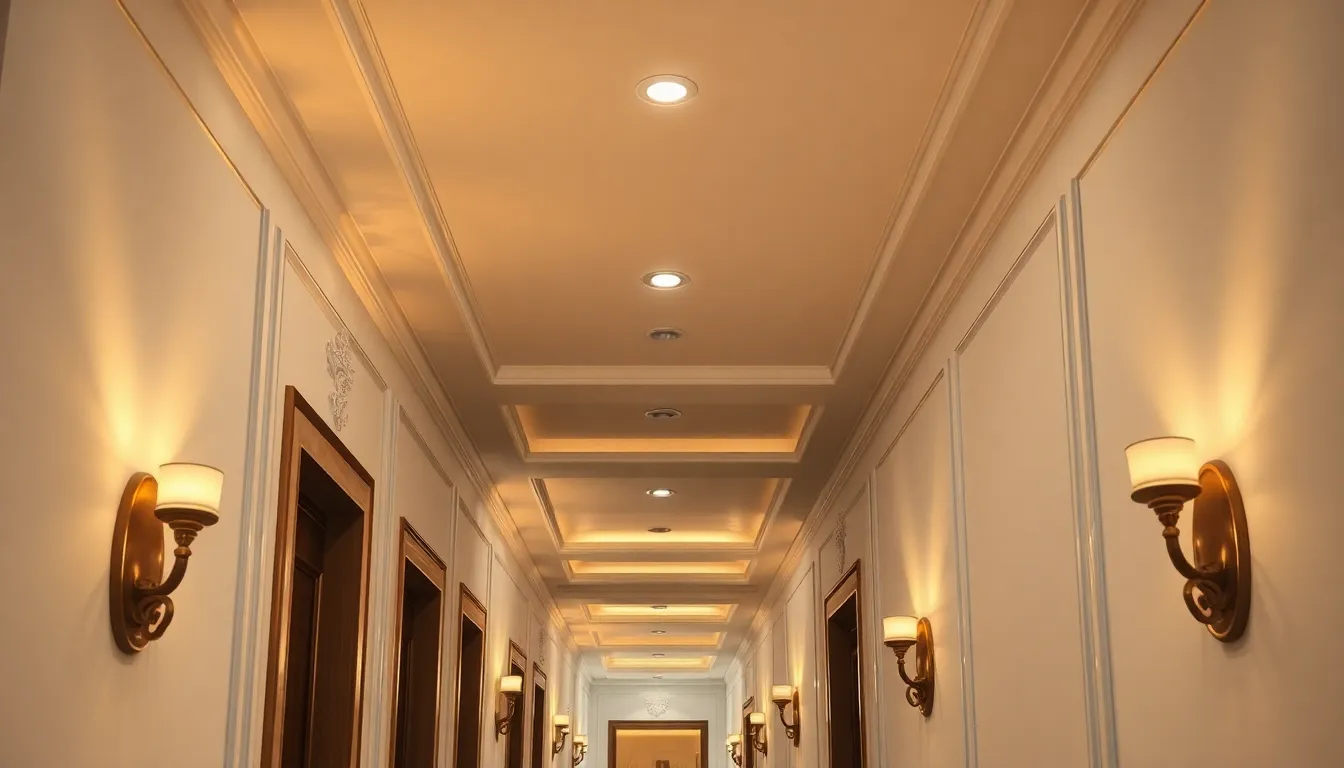
Strategic lighting transforms narrow hallways from cramped corridors into welcoming pathways that enhance your home’s overall flow.
Use Recessed Ceiling Lights for Clean Lines
Recessed ceiling lights eliminate visual clutter while providing essential illumination throughout your narrow hallway. We recommend installing these fixtures every 6 to 8 feet along the corridor to ensure even light distribution without creating dark spots.
Spacing becomes crucial when working with limited width since overlapping light patterns can make the space feel more expansive. Choose LED recessed lights with warm white temperatures between 2700K and 3000K to create an inviting atmosphere.
Flush mount alternatives work exceptionally well when you need to maintain at least seven feet of clearance between the floor and fixture bottom. Installing multiple flush mounts in series creates the illusion of a grand space while keeping the ceiling line uninterrupted.
Install Wall Sconces at Eye Level
Wall sconces positioned at eye level create balanced ambient lighting that makes narrow hallways feel more spacious and welcoming. We suggest mounting these fixtures between 60 and 66 inches from the floor to achieve optimal light distribution.
Translucent fixtures with glass or reflective elements bounce light off surrounding surfaces to amplify brightness throughout the corridor. Choose sconces that extend no more than 4 to 6 inches from the wall to maintain safe passage width.
Pairing different fixture types enhances visual interest while providing layered illumination. Combine interesting sconces with flush mount ceiling lights for a cohesive lighting scheme that addresses both ambient and task lighting needs.
Add LED Strip Lighting Along Baseboards
LED strip lighting along baseboards creates a modern, sleek appearance while adding subtle illumination that guides movement through narrow spaces. We install these strips just above the baseboard trim to achieve a floating effect that visually expands the corridor.
Color temperature matters when selecting LED strips since cooler whites (4000K to 5000K) can make the space feel clinical. Warm white LEDs between 2700K and 3000K provide comfortable ambiance that complements your home’s existing lighting.
Stair lighting applications become particularly effective in tight spaces where traditional fixtures might create obstacles. Install strip lights above baseboards on both sides of the hallway to eliminate shadows and create continuous illumination from floor to ceiling.
Create Visual Width With Mirror Tricks

Mirrors offer one of the most effective methods for expanding narrow hallways visually. These reflective surfaces double the apparent width by bouncing light and creating depth where none exists naturally.
Place Large Mirrors on One Wall
Position a single oversized mirror along the longest wall to instantly transform your narrow corridor into what appears to be a much wider space. We recommend choosing mirrors that span at least 60% of the wall’s length for maximum impact. Strategic placement opposite a window amplifies natural light throughout the hallway, while positioning mirrors across from artwork or decorative elements creates interesting visual layers. Floor-to-ceiling mirrors work exceptionally well in hallways with high ceilings, as they draw the eye upward and outward simultaneously.
Use Mirrored Doors for Closets
Replace traditional closet doors with mirrored alternatives to achieve both functional storage and visual expansion without sacrificing floor space. Mirrored bifold doors work particularly well in narrow hallways since they don’t swing into the walkway when opened. We’ve found that full-length mirrored doors create the strongest illusion of width, especially when they reflect lighting fixtures or windows from the opposite direction. Consider frameless mirrored doors for a sleek, contemporary look that blends seamlessly with modern hallway designs.
Install Mirror Tiles for Textural Interest
Create ever-changing visual texture with strategically placed mirror tiles that add dimension while maintaining the space-expanding benefits of reflective surfaces. Arrange mirror tiles in geometric patterns like subway layouts or herringbone designs to introduce movement and sophistication. We suggest using 12-inch square mirror tiles with beveled edges for optimal light reflection and visual interest. Install tiles at varying heights to create a custom accent wall that breaks up monotonous corridor walls while preserving the width-improving properties that make narrow hallways feel more spacious.
Choose Light Colors to Open Up the Space

Light colors create the foundation for transforming narrow hallways from cramped corridors into bright, welcoming spaces. We’ll explore how strategic color choices reflect more light and visually expand your hallway’s dimensions.
Paint Walls in Soft Neutral Tones
Soft neutral tones like beige, cream, and pale gray serve as our primary weapons against narrow hallway claustrophobia. These colors reflect natural and artificial light throughout the space, creating an immediate sense of openness that darker shades simply can’t achieve.
Beige walls provide warmth while maintaining the spacious feel we’re after in tight corridors. Cream offers a classic elegance that works with virtually any decor style, from traditional to contemporary. Pale gray delivers a modern sophistication that pairs beautifully with white trim and fixtures.
We recommend testing paint samples in different lighting conditions before committing to a color. Natural light reveals undertones differently than artificial lighting, so observe your chosen shade during morning, afternoon, and evening hours to ensure it maintains its space improving qualities throughout the day.
Select Light-Colored Flooring Materials
Light-colored flooring materials like white oak or light maple wood contribute significantly to creating a brighter, more spacious hallway atmosphere. These flooring choices reflect upward light that bounces off walls and ceilings, amplifying the overall brightness of your narrow space.
White or blonde hardwood floors offer durability while maintaining that essential light reflecting quality we need. Light oak provides subtle grain patterns that add visual interest without overwhelming the narrow corridor. Bamboo flooring in natural tones delivers an eco friendly option that maintains the bright, open feel.
We suggest considering light colored luxury vinyl planks if budget constraints limit hardwood options. These materials mimic the appearance of light wood while offering easier maintenance and installation in narrow hallway applications.
Use White or Cream Ceiling Paint
White or cream ceiling paint maintains the illusion of height and prevents the ceiling from visually pressing down on narrow hallway occupants. These light ceiling colors work in harmony with your wall colors to create a cohesive, expansive feeling throughout the space.
Pure white ceilings offer the maximum light reflection potential, bouncing illumination back down into the hallway corridor. Cream ceilings provide a softer alternative that coordinates beautifully with warm neutral wall tones while still maintaining excellent light reflecting properties.
We recommend using a flat or matte finish on ceiling paint to minimize imperfections and create smooth light distribution. Semi gloss or satin finishes can create unwanted reflections that might make your narrow hallway feel more confined rather than open.
Add Personality With Gallery Wall Displays
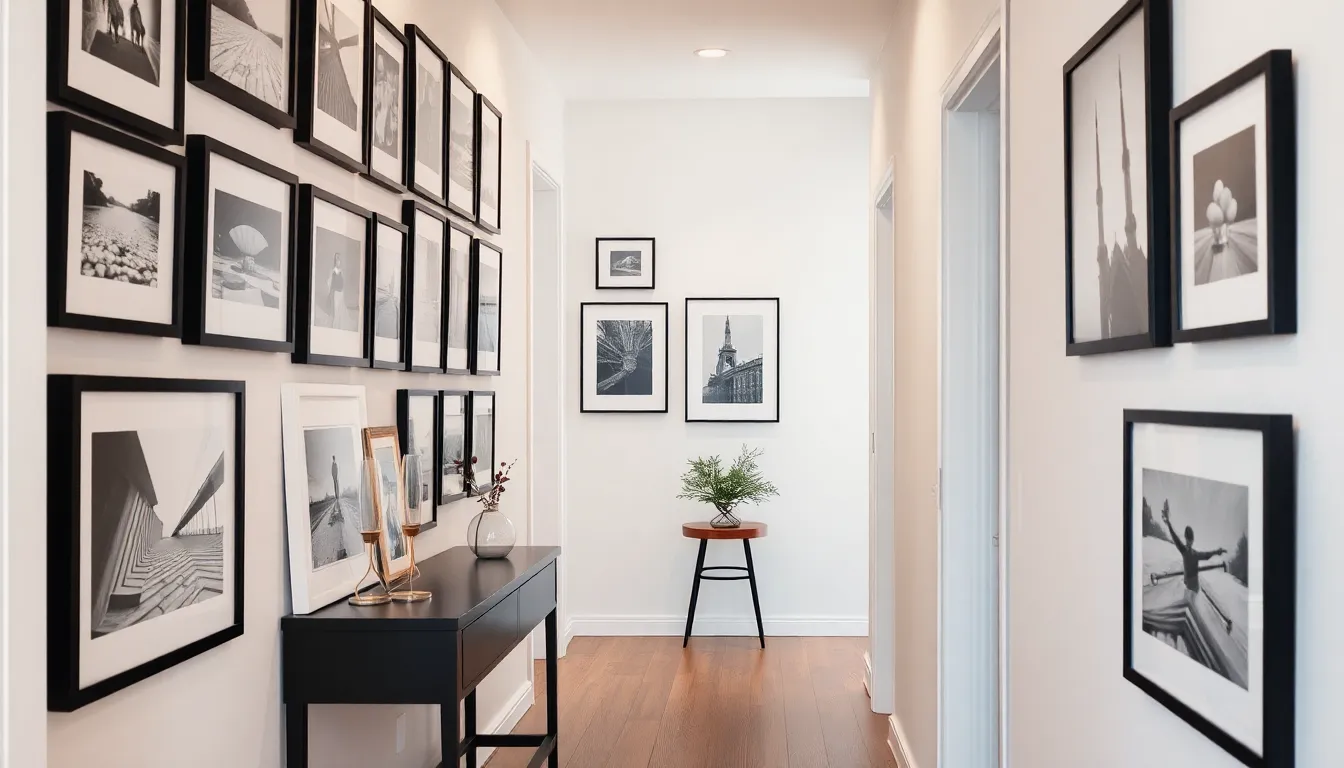
Gallery walls transform narrow hallways from simple passageways into captivating art showcases. We can create visual interest and personal expression in these often-overlooked spaces through thoughtful curation and strategic placement.
Create a Curated Photo Collection
Curated photo collections bring warmth and personality to narrow corridor walls. We recommend selecting 5 to 7 meaningful photographs that tell a cohesive story, whether through family memories, travel experiences, or artistic themes. Personal photographs work exceptionally well in hallways since visitors naturally pause to admire them while moving through the space.
Choose images that share common elements like color tones, subjects, or time periods to maintain visual unity. We suggest mixing black and white photos with color images in a 60/40 ratio to create sophisticated contrast. Professional family portraits can anchor the collection, while candid moments add authentic charm and conversation starters.
Mix Artwork Sizes for Visual Interest
Mixed artwork sizes create ever-changing visual flow that draws the eye along narrow hallway walls. We recommend using three distinct frame sizes: large anchor pieces measuring 16×20 inches, medium supports at 11×14 inches, and small accents in 8×10 inch formats. This size variation prevents the monotonous grid pattern that can make narrow spaces feel rigid.
Position your largest piece first as the focal point, then arrange medium and small works around it to create natural movement. We suggest maintaining 2 to 3 inches between frames to allow each piece breathing room while keeping the display cohesive. Asymmetrical arrangements often work better than perfect symmetry in narrow corridors since they encourage natural walking pace and viewing.
Use Consistent Frame Colors
Consistent frame colors unify gallery wall displays and prevent narrow hallways from appearing cluttered. We recommend choosing one primary frame color that complements your hallway’s existing color scheme, whether classic black, warm white, or natural wood tones. This unified approach creates visual calm while allowing the artwork itself to command attention.
Black frames work particularly well against light colored walls, creating crisp definition that enhances each piece. White or cream frames blend seamlessly with neutral hallway palettes, making the artwork appear to float on the wall. Natural wood frames add warmth and texture, especially effective when they echo flooring materials or other wooden elements in adjacent spaces.
Incorporate Functional Furniture Pieces
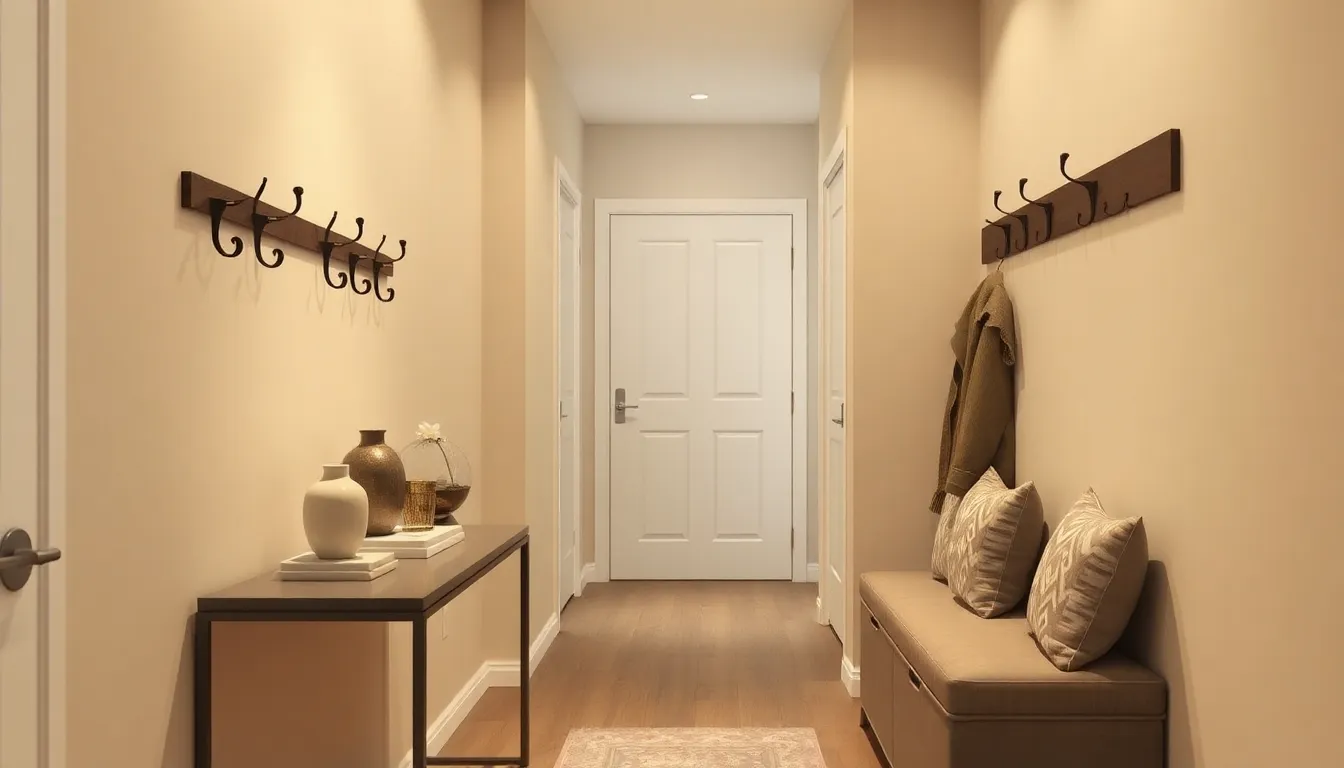
Transforming narrow hallways into functional spaces requires carefully selected furniture that maximizes utility without compromising walkway flow. We’ll explore three essential furniture categories that deliver both practicality and style in tight corridors.
Select Narrow Console Tables
Console tables with slim profiles serve as the foundation for functional hallway design. We recommend choosing pieces that measure no more than 12 inches deep to maintain clear walking paths while providing essential surface space for keys, mail, and decorative items.
Storage capabilities distinguish the best narrow console tables from purely decorative options. Models featuring drawers or lower shelves offer concealed organization for everyday essentials without creating visual clutter in your limited space.
Positioning these tables strategically along one wall creates an elegant focal point while maintaining hallway accessibility. We suggest measuring your corridor width before shopping to ensure adequate clearance for comfortable movement past the furniture.
Add Slim Benches With Storage
Benches designed specifically for narrow spaces offer dual functionality that traditional seating cannot match. We favor models with hidden storage compartments that accommodate shoes, bags, seasonal accessories, and other items that typically create hallway mess.
Length becomes more important than width when selecting hallway benches. We recommend choosing pieces that span 36 to 48 inches long while maintaining depths under 16 inches to preserve walking space efficiency.
Styling opportunities emerge when you add coordinating throw pillows or cushions to these storage benches. We find that decorative elements help integrate the furniture seamlessly with your existing hallway design while providing comfortable seating for putting on shoes.
Choose Wall-Mounted Coat Racks
Wall-mounted answers eliminate floor space requirements while delivering essential coat storage functionality. We prefer installing these racks at heights between 60 to 66 inches to accommodate various family members’ needs without overwhelming narrow wall space.
Multiple hook configurations offer flexibility for different storage requirements throughout seasons. We suggest selecting racks with 4 to 6 individual hooks to handle coats, hats, scarves, and bags without creating overcrowded appearances.
Installation positioning affects both functionality and visual balance in narrow corridors. We recommend mounting coat racks on the wall opposite any console tables or benches to distribute visual weight evenly while maintaining clear sight lines through the hallway.
Use Vertical Stripes to Create Height Illusion
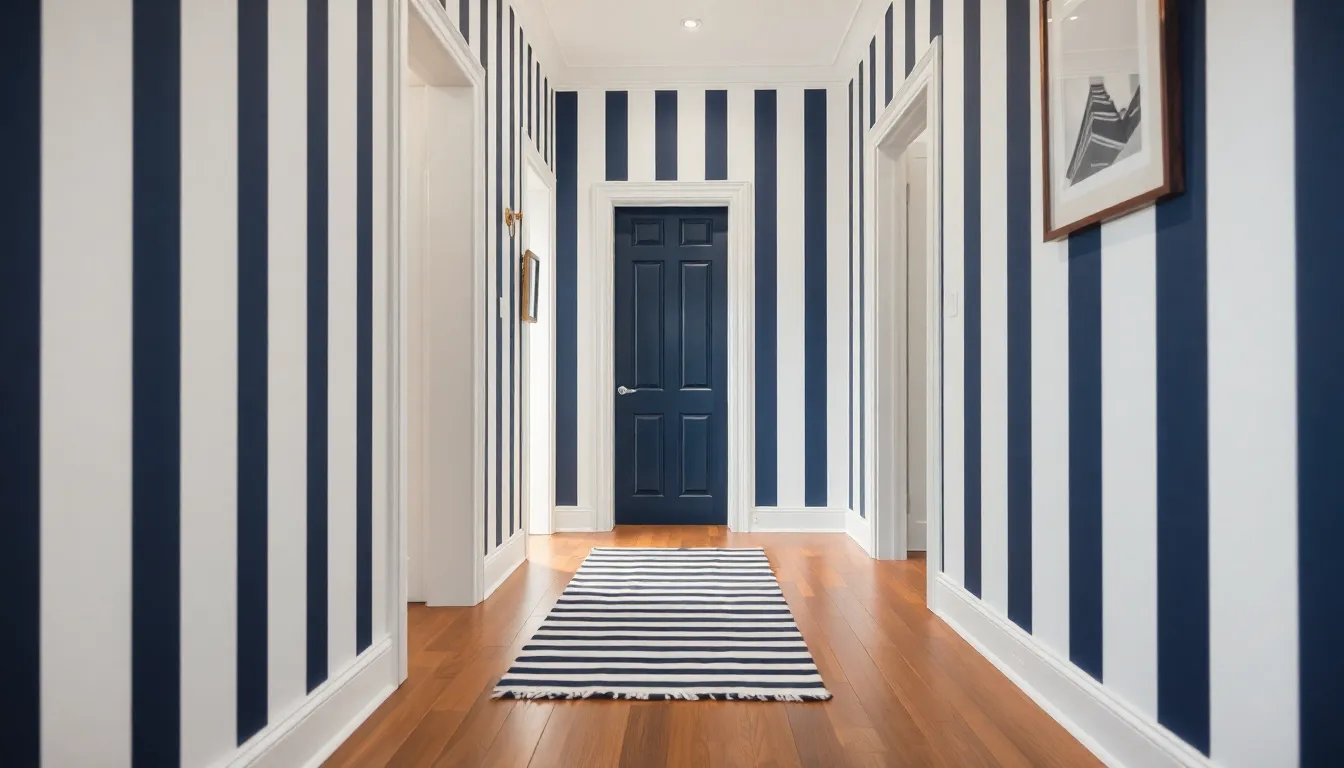
Vertical stripes offer a powerful visual technique to counteract the confined feeling of narrow hallways by drawing the eye upward and creating the perception of greater height.
Apply Striped Wallpaper Designs
Striped wallpaper creates an immediate height illusion that transforms cramped corridors into seemingly taller spaces. We recommend selecting wallpaper with narrow vertical stripes in contrasting colors to maximize the visual impact. Bold combinations like navy and white or charcoal and cream provide striking results while maintaining sophistication.
Positioning striped wallpaper on a single accent wall prevents overwhelming the narrow space while still achieving the desired height effect. This approach works particularly well on the wall opposite the entrance, drawing visitors’ attention upward as they enter the hallway. Professional wallpaper installation ensures straight lines that maintain the optical illusion’s effectiveness.
Paint Vertical Stripe Patterns
Painted vertical stripes offer a cost effective alternative to wallpaper while providing similar height improving benefits. We suggest using painter’s tape to create crisp, even lines with stripes measuring 4 to 6 inches wide for optimal visual impact. Alternating between a light base color and a shade that’s 2-3 tones darker creates subtle definition without overwhelming the space.
Starting from the ceiling and working downward helps ensure consistent stripe alignment throughout the hallway’s length. This technique requires careful measurement and planning, but the results significantly improve the perceived height of narrow corridors. Semi gloss paint finishes work best for striped designs as they provide easier maintenance and enhanced light reflection.
Add Striped Runner Rugs
Striped runner rugs visually elongate narrow hallways while adding comfort and style to hard flooring surfaces. We recommend selecting rugs with horizontal stripes that run perpendicular to the hallway’s length, creating an optical illusion that makes the space appear wider. Runner rugs measuring 2 to 3 feet wide provide adequate coverage without overwhelming narrow corridors.
Positioning the runner rug to extend at least 6 inches beyond doorway thresholds creates visual continuity throughout the hallway’s length. This placement strategy guides foot traffic while maintaining the space improving effect. Machine washable runners offer practical benefits for high traffic hallways, ensuring long term durability and easy maintenance.
Install Smart Organization Systems
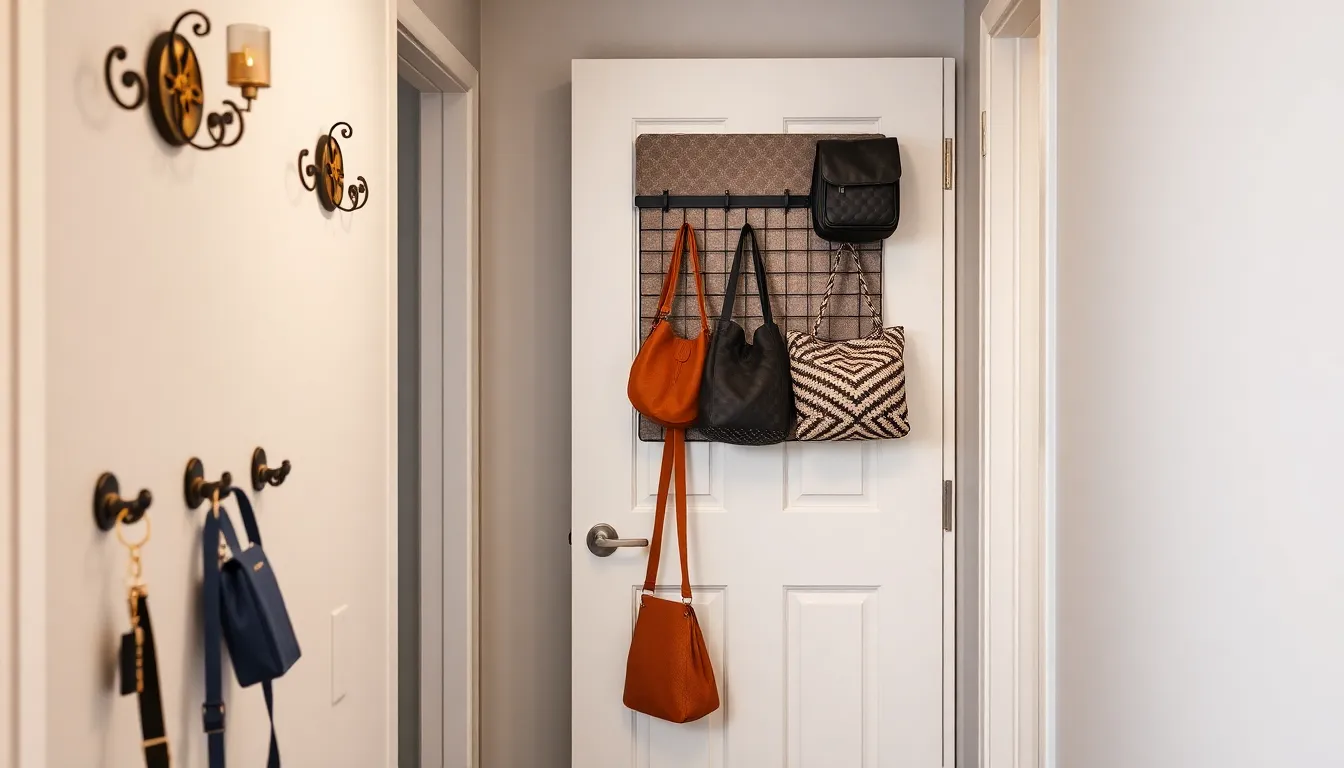
Transforming narrow hallways into organized spaces requires strategic placement of smart storage answers that maximize vertical surfaces while maintaining clear walking paths.
Add Wall-Mounted Key Holders
Wall-mounted key holders eliminate countertop clutter while keeping essentials within easy reach. Peg rails installed along hallway walls can accommodate keys, coats, and bags without consuming valuable floor space. We recommend positioning these rails at eye level, approximately 5 to 6 feet from the floor, to ensure accessibility for all family members.
Multiple hook systems work particularly well in narrow corridors because they distribute weight evenly across the wall surface. Installing a series of individual hooks rather than a single large rack allows for customized spacing based on your exact storage needs. Decorative hooks with vintage or modern finishes can double as wall art while serving their functional purpose.
Create Mail and Document Stations
Mail organization becomes effortless with dedicated document stations that prevent paper accumulation on surfaces. Console tables paired with woven baskets underneath provide immediate sorting space for incoming mail, bills, and important documents. These slim profile tables, measuring no more than 10 inches deep, fit comfortably in narrow hallways without impeding foot traffic.
Wall-mounted mail sorters offer an alternative solution for extremely tight spaces where floor furniture isn’t practical. Installing a multi-compartment organizer at chest height creates designated spaces for different family members or document types. Adding a small magnetic board nearby allows for displaying urgent reminders or schedules without creating visual chaos.
Use Over-Door Organizers
Over-door storage systems maximize unused vertical space without requiring wall installation or floor area. These organizers attach securely to standard interior doors, creating instant storage for jackets, hats, bags, or cleaning supplies. The key advantage lies in their ability to transform dead space into functional storage areas.
Fabric pocket organizers work exceptionally well for lightweight items like gloves, scarves, or small accessories. For heavier items such as coats or backpacks, metal over-door hooks with multiple arms provide sturdy support. We suggest choosing organizers with adjustable components to accommodate doors of varying thickness and ensure proper fit without damaging door frames.
Conclusion
We’ve shown you that narrow hallways don’t have to be design afterthoughts. With the right combination of clever storage answers vertical elements and strategic lighting these spaces can become some of the most functional and visually appealing areas in your home.
The key lies in embracing the challenge rather than fighting against it. By implementing smart color choices incorporating mirrors and adding personality through curated displays you’ll transform your narrow corridor into a welcoming pathway that enhances your entire living space.
Remember that every design decision should serve a dual purpose in narrow hallways. Whether it’s a slim console table that provides storage or LED strip lighting that guides movement each element contributes to both form and function. Your narrow hallway can truly become a showcase of thoughtful design.
Frequently Asked Questions
How can I make my narrow hallway look wider?
Use light colors like beige, cream, or pale gray for walls and ceilings to reflect light and create openness. Install a large mirror spanning at least 60% of one wall to create the illusion of width. Add strategic lighting with recessed ceiling lights and LED strip lighting along baseboards to brighten the space.
What storage solutions work best in narrow hallways?
Install floor-to-ceiling shelving units with 6-10 inch depths to maximize vertical space. Consider hidden storage behind wall panels with recessed cabinets for seamless organization. Utilize under-stair compartments with pull-out drawers for seasonal items, and combine closed cabinets with open shelving for visual interest.
What type of lighting should I use in a narrow hallway?
Install recessed ceiling lights every 6-8 feet using warm white LEDs for even illumination. Add wall sconces at eye level for balanced ambient lighting. Consider LED strip lighting along baseboards for a modern touch and to guide movement through the space.
How do I choose the right furniture for a narrow hallway?
Select narrow console tables no more than 12 inches deep for surface space without blocking walkways. Choose slim benches with hidden storage for dual functionality. Install wall-mounted coat racks to eliminate floor space requirements while providing essential storage.
Can I use patterns in a narrow hallway?
Yes, vertical stripes through wallpaper or painted patterns can create an illusion of height by drawing the eye upward. Use striped runner rugs to visually elongate the space. Choose narrow vertical designs in contrasting colors for a sophisticated look while maintaining the space-enhancing effect.
How do I organize items in a narrow hallway?
Install wall-mounted key holders and peg rails to keep essentials accessible while minimizing clutter. Create dedicated mail stations using slim console tables or wall-mounted organizers. Use over-door organizers to maximize vertical space without taking up floor area.
What colors should I avoid in narrow hallways?
Avoid dark colors like deep blues, blacks, or rich browns as they absorb light and make spaces feel smaller and more cramped. Skip bold, bright colors that can overwhelm the limited space. Instead, stick to light, neutral tones that reflect light and create airiness.
How can I add personality to my narrow hallway?
Create gallery wall displays with 5-7 meaningful photographs that share common elements for visual unity. Mix artwork sizes for visual interest while using consistent frame colors to prevent clutter. Choose pieces that reflect your personal style without overwhelming the narrow space.

